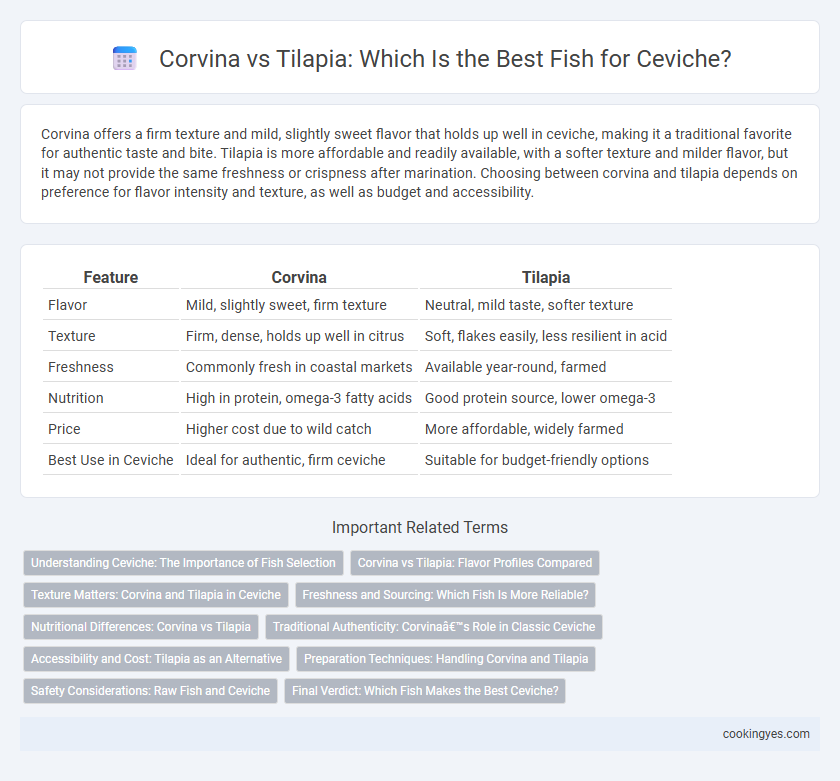Corvina offers a firm texture and mild, slightly sweet flavor that holds up well in ceviche, making it a traditional favorite for authentic taste and bite. Tilapia is more affordable and readily available, with a softer texture and milder flavor, but it may not provide the same freshness or crispness after marination. Choosing between corvina and tilapia depends on preference for flavor intensity and texture, as well as budget and accessibility.
Table of Comparison
| Feature | Corvina | Tilapia |
|---|---|---|
| Flavor | Mild, slightly sweet, firm texture | Neutral, mild taste, softer texture |
| Texture | Firm, dense, holds up well in citrus | Soft, flakes easily, less resilient in acid |
| Freshness | Commonly fresh in coastal markets | Available year-round, farmed |
| Nutrition | High in protein, omega-3 fatty acids | Good protein source, lower omega-3 |
| Price | Higher cost due to wild catch | More affordable, widely farmed |
| Best Use in Ceviche | Ideal for authentic, firm ceviche | Suitable for budget-friendly options |
Understanding Ceviche: The Importance of Fish Selection
Choosing the right fish is crucial for authentic ceviche, with corvina offering a firm texture and mild, slightly sweet flavor that complements the citrus marinade perfectly. Tilapia, while more affordable, has a softer texture and a milder taste that can dilute the traditional ceviche experience. Prioritizing fresh, high-quality corvina enhances the dish's balance of acidity and freshness, ensuring the ideal seafood bite characteristic of South American ceviche.
Corvina vs Tilapia: Flavor Profiles Compared
Corvina offers a delicate, slightly sweet flavor with a firm, flaky texture that holds up well in ceviche, providing a fresh oceanic taste. Tilapia has a milder, more neutral flavor with a softer texture, making it less distinctive but versatile for absorbing citrus and spice marinades. Choosing corvina over tilapia enhances the ceviche's authentic, vibrant taste with a more pronounced seafood essence.
Texture Matters: Corvina and Tilapia in Ceviche
Corvina offers a firm, flaky texture that holds well in the acidic marinade of ceviche, providing a satisfying bite without becoming mushy. Tilapia, while milder in flavor, has a softer, more delicate texture that can break down quickly in citrus, potentially resulting in a less structured ceviche. Choosing corvina enhances the traditional ceviche experience by balancing tender chewiness with durability, whereas tilapia suits those preferring a gentler, creamier mouthfeel.
Freshness and Sourcing: Which Fish Is More Reliable?
Corvina is often favored for ceviche due to its superior freshness and reliable sourcing, primarily because it is widely caught along the Pacific coasts of Latin America where ceviche is a traditional dish. Fresh corvina has a firm texture and subtle flavor that holds up well in acidic marinades, ensuring optimal taste and safety. Tilapia, while more readily available and affordable, is typically farmed with variable freshness and quality, making it a less consistent choice for authentic ceviche preparations.
Nutritional Differences: Corvina vs Tilapia
Corvina offers higher levels of omega-3 fatty acids and essential minerals such as selenium compared to tilapia, enhancing the heart-healthy profile of ceviche made with this fish. Tilapia contains a slightly higher protein content per serving but has lower amounts of beneficial polyunsaturated fats. Choosing corvina for ceviche boosts intake of vital nutrients linked to anti-inflammatory and cardiovascular benefits.
Traditional Authenticity: Corvina’s Role in Classic Ceviche
Corvina is the quintessential choice for traditional ceviche, prized for its firm, white flesh and mild flavor that perfectly absorbs the citrus marinade. Its natural texture ensures the fish remains tender yet resilient, maintaining the authentic mouthfeel that defines classic Peruvian and Latin American ceviche. In contrast, tilapia's softer meat and stronger fishy taste deviate from the time-honored ceviche experience, making corvina the superior, culturally authentic option for ceviche preparation.
Accessibility and Cost: Tilapia as an Alternative
Tilapia serves as a more accessible and cost-effective alternative to corvina when preparing ceviche, especially in regions where corvina is scarce or expensive. Its mild flavor and firm texture allow it to absorb citrus marinades well, maintaining the traditional ceviche profile. Choosing tilapia can make ceviche preparation more affordable without sacrificing quality, making it ideal for budget-conscious cooks.
Preparation Techniques: Handling Corvina and Tilapia
Corvina requires careful skin removal and deboning due to its firmer texture, which helps maintain its structural integrity in ceviche. Tilapia, being softer and more delicate, demands gentle handling and quicker marination to prevent disintegration in citrus juices. Proper filleting and controlled marinating times ensure optimal texture and flavor release from both fish varieties in ceviche preparations.
Safety Considerations: Raw Fish and Ceviche
Corvina is preferred over tilapia for ceviche due to its firm texture and lower risk of parasites commonly found in freshwater fish like tilapia. The saltwater origin of corvina reduces the likelihood of harmful bacteria, enhancing food safety when consumed raw. Proper handling, freezing at -20degC for at least 7 days, and sourcing from reputable suppliers are critical to minimizing parasitic infection risks regardless of fish type.
Final Verdict: Which Fish Makes the Best Ceviche?
Corvina offers a firm texture and mild, slightly sweet flavor that holds up well to the citrus marinade in ceviche, making it a popular choice in traditional recipes. Tilapia has a softer texture and a more neutral taste that absorbs flavors quickly but can become mushy if over-marinated. Corvina is generally considered the best fish for ceviche due to its ideal balance of firmness and flavor retention, which enhances the overall freshness and authenticity of the dish.
Corvina vs tilapia for ceviche fish base Infographic

 cookingyes.com
cookingyes.com